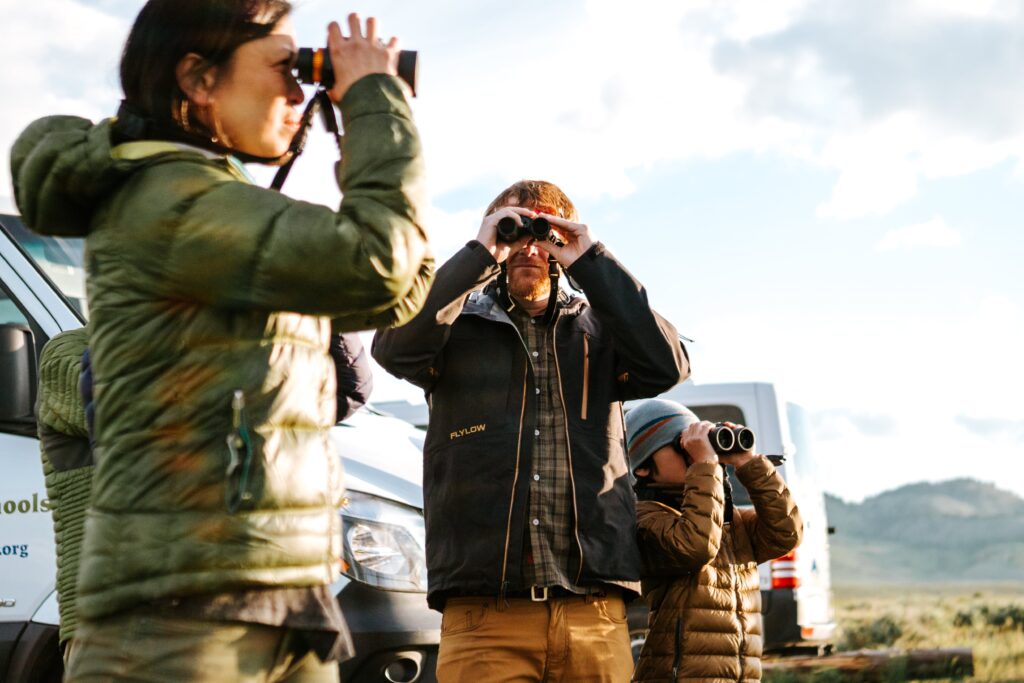Grand Teton and Yellowstone National Parks are some of the best places to observe wild North American animals. Finding the wildlife on the other hand is a whole other feat. To help you spot wildlife in the national parks, we’ve put together some tips from our Wildlife Expeditions guides.
Get out early or late
Knowing when the animal you’re seeking is most active is key to spotting them in action. Many of the charismatic megafauna (e.g. moose, elk, bears) in this area are crepuscular, meaning that they’re most active at dawn and dusk as compared to diurnal (most active during the day) and nocturnal (most active at night) animals. Once you have an idea of who you’re looking for, plan to search at a time of day they’re most likely to be out and about.
Look for other people, but be aware of local rules and park property
More often than not, you’re searching for wildlife alongside hundreds of others who are out on the lookout for the same animals, including guides like those here at Teton Science Schools. Keep your eyes out for cars stopped on the side of the road or congregated in pullouts. They can clue you in to the presence of animals, but can also lead to frustrating experiences like traffic jams or worse, damage and stress to the local flora and fauna you’re there to see. When you stop, use pull outs as often as you can. If no pull out is available and there is a safe place to pull off the road, you must get all four wheels over the white line. If these two options are not available, you will have to continue driving, find a safe place to park and walk back.
Take some time in the right habitat
If you are looking for a specific animal, understanding where it lives and eats can highly increase your chances of spotting it. Do some research on animals you would like to see and head to their favorite habitats. Be prepared to spend some time looking there, too. Like humans, animals aren’t spending 100% of their time in one location each day. But like humans, in enough time we’ll come back to our favorite spots when it’s time to catch a good meal.
Look closely
When you get to the right habitat and you have a safe place to park, look closely and slowly across a landscape. Many animals might not be evident right away. When our guides are scanning a landscape, they are often looking for something that stands out– a particularly dark spot, a flash of movement, anything that catches their eye. Sometimes, these little clues are all that’s needed to help you find what you’re looking for. Having the right optics can also help out greatly.
Hire a guide
If you’re unsure or overwhelmed by the idea of seeking wildlife out on your own, booking a wildlife tour is a great way to take the pressure off and leave the hard part to the experts. Our guides at Teton Science Schools are out experiencing this landscape, and the animals that call it home, every day. Not only are they happy to share their skill in finding wildlife with you, but they’re storytelling and passion for this place will leave you feeling a grand connection with this special land and the animals that call it home.
Written by Wildlife Expeditions Guide, Dylan Klinesteker. Dylan’s passion for the natural world started as a young person road tripping across the country to National Parks. They moved to Bellingham Washington for college and got a degree from Western Washington University in Environmental Education and not only grew their love of the outdoors, but the skills to share them with others. Working for Death Valley National Park, Redwoods National and State Parks, and North Cascades National Park were all great opportunities to see some very different and amazing landscapes. Dylan came to Teton Science Schools in 2016 and has loved sharing their backyard with visitors from around the world. In their free time, Dylan likes to take pictures with their vintage Leica lenses, ride bicycles, and spend time with their wife traveling in their 1988 VW Vanagon Westfalia.


